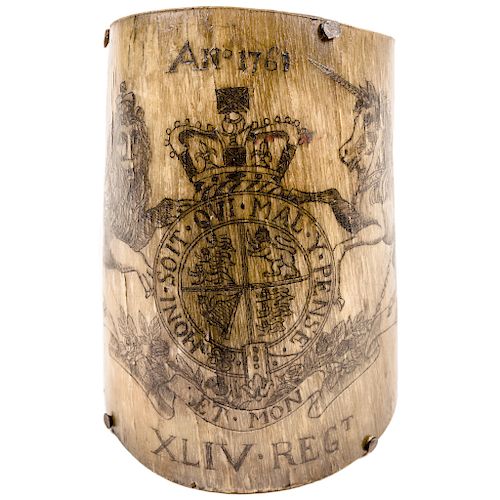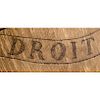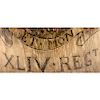1761 French and Indian War British 44th Regiment of Foot Engraved Horn Container
Lot 97
Estimate:
$4,000 - $6,000
Absentee vs Live bid
Two ways to bid:
- Leave a max absentee bid and the platform will bid on your behalf up to your maximum bid during the live auction.
- Bid live during the auction and your bids will be submitted real-time to the auctioneer.
Bid Increments
| Price | Bid Increment |
|---|---|
| $0 | $10 |
| $200 | $20 |
| $300 | $25 |
| $500 | $50 |
| $1,000 | $100 |
| $2,000 | $200 |
| $3,000 | $250 |
| $5,000 | $500 |
| $10,000 | $1,000 |
| $20,000 | $2,000 |
| $30,000 | $2,500 |
| $50,000 | $5,000 |
| $100,000 | $10,000 |
| $200,000 | $20,000 |
| $300,000 | $25,000 |
| $500,000 | $50,000 |
About Auction
By Early American History Auctions
Jun 1, 2019
Set Reminder
2019-06-01 12:00:00
2019-06-01 12:00:00
America/New_York
Bidsquare
Bidsquare : Historic Autographs, Colonial Currency, Political Americana & Revolutionary War Era
https://www.bidsquare.com/auctions/early-american-history-auctions/historic-autographs-colonial-currency-political-americana-revolutionary-war-era-4152
Historic Autographs, Coins, Currency, Political, Americana, Historic Weaponry and Guns, John Adams, Thomas Jefferson, Early American History Auctions auctions@earlyamerican.com
Historic Autographs, Coins, Currency, Political, Americana, Historic Weaponry and Guns, John Adams, Thomas Jefferson, Early American History Auctions auctions@earlyamerican.com
- Lot Description
Colonial America
1761-Dated French and Indian War Hand-Engraved Horn British "Personal Container" British 44th Regiment of Foot
1761-Dated French and Indian War Period, Regiment Identified, Decorative Hand-Engraved Powder Horn, British "Personal Container" which would have been used to carry Powder, Sugar, Salt, Rum, etc., Choice Very Fine.
1761-Dated French and Indian War Period, Important Hand-Engraved Decorative Horn, British Powder Horn made "Personal Container" made from 6" tall and 4.5" wide which was typically used as a method for transporting smaller quantities of goods such as Powder, Sugar, Salt, Rum, etc.. The top and bottom wooden cap ends are sealed and also nailed with period blacksmith made, mostly round flat head small nails. It is Hand-Engraved with British Crest with a Crowned Lion, and Chained Unicorn vignettes on either side of a Crowned Circular Banner with the engraved text legends: "Honisoit Quimal Ypense" and "Dieu Et Mon Droit" below. Identified to the "XLIV" of 44th Regiment of Foot. Similar to examples listed on Pages 154 & 155 of "Collector's Illustrated Encyclopedia of the American Revolution" by Neumann & Kravic. "Honi soit qui mal y pense" are French words that are often found on Britain's Royal Coat of Arms. Its basic translation is meant to covey, "Shame on the one who sees something bad (or evil) in it." "Dieu et mon droit" meaning is "God and my right" which is the motto of the Monarch of the United Kingdom outside Scotland. It usually appears on a scroll beneath the shield of the version of the Coat of Arms. This Horn Container has extensive decoration and provenance to a British Regiment that saw lots of military action in 1761 and throughout the French and Indian War Period. There is honest actual wear and has some traces of powder? within the container. The engraving remains clear and well presented so it is an excellent example for any collection period display. Rare.
The British 44th Regiment of Foot embarked for North America in January 1755 for service in the French and Indian War and took part in the Battle of the Monongahela where Colonel Sir Peter Halkett was killed while commanding the regiment. The regiment went on to fight at the Battle of Carillon in July 1758 and the Battle of Fort Niagara in July 1759 before returning home in 1765. This historic British regiment returned to North America landing in Boston in 1775 for service in the American Revolutionary War. It saw action at the Battle of Brooklyn in August 1776, the Battle of Brandywine in September 1777, and the Battle of Germantown in October 1777, as well as the Battle of Monmouth in June 1778. In May 1780 the regiment moved to Canada, returning home in September 1786. In 1782, most British regiments of foot were given "county" designations, and thus this regiment became the 44th (the East Essex) Regiment of Foot.
- Shipping Info
-
Early American provides in-house worldwide shipping. Please contact us directly if you have questions about your specific shipping requirements.
-
- Buyer's Premium



 EUR
EUR CAD
CAD AUD
AUD GBP
GBP MXN
MXN HKD
HKD CNY
CNY MYR
MYR SEK
SEK SGD
SGD CHF
CHF THB
THB















![1667 Land Deed [Massachusetts Bay Colony / Boston] on Parchment](https://s1.img.bidsquare.com/item/m/2949/29492002.jpeg?t=1TIB0e)


